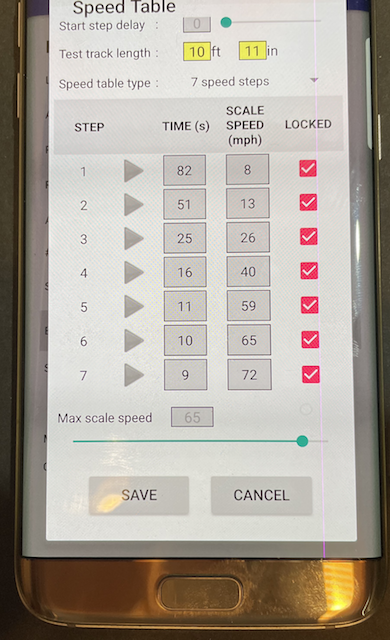The outer loop distance of the layout is 27 feet 9 inches. It was used for the configuration process.  Four Soshine 280mAh LiFe 10440 size batteries were placed in the battery car's two AAA battery boxes, which had been wired in series. The Soo Line boxcar top was not used during the configuration process. Using batteries does not supply a constant voltage to the decoder. The voltage is always decreasing as the locomotive is run. Because of this, the 7 Step configuration runs were performed in reverse order from Step 7 back to Step 1. The top calculated scale speed noted during this process was 72 mph. The slowest was 3 mph. It takes approximately 7 minutes for the locomotive to traverse 27 feet 9 inches at a scale 3 mph. (A great time to do some clean up, get more coffee, or whatever.) The locomotive ran smoothly at all 7 voltage steps. Even Step 1, at a calculated scale speed of 3 mph was very smooth with no noticeable jerking. The maximum speed can be set in the Configure section of the App. 65 mph is the maximum for a GP15-1, therefore 65 scale mph was chosen as the limiting top speed in the App. The CSX, with its 53' gondola battery car, had never been configured using this layout. The CSX version was also configured on the outer loop of the layout using a freshly charged set of Soshine 280mAh LiFe batteries. Its performance during the configuration was, for all practical purposes, identical to the new Conrail's. In Step 7 of the LocoFi™ App Speed Table, the CSX, with either type of battery, showed 72 mph as the calculated resulting speed. The CSX leads, when converted from a 3S 300mAh Li-Po to an IMR 10440 3S 350mAh resultant battery, were originally soldered to the battery box leads directly with no connector at this time. The Conrail only showed a calculated 65 mph for Step 7. That might have indicated a lower voltage reaching the decoder at that time for the Conrail.  Small connectors tend to have quite high resistance. I decided that connectors were not beneficial for me at this time, so the connectors in the gondola of the Conrail setup were removed and the wires betweeen the loco and the battery car/gondola were soldered. I now use MicroMark Micro Connectors. They seem to be working well as of September 2022. The Conrail was reconfigure in the LocoFi™ App Speed Table, using 7 Steps.  The Conrail now showed a calculated 72 mph for Step 7. Unfortunately, that did NOT prove that the original connectors were the "problem". There were other variables that I could not control. 1. The very same 10440 batteries were not used in the gondola. All the batteries had gotten moved around and grouped differently during all the "test runs".
I still was okay with removing the connectors for awhile, but in September of 2022 I added MicroMark Micro Connectors. Note that the following Derived Run Time Procedure was completed using a 3.7V under load cut off, not the now recommended 3.5V under load cut off. After recharging the batteries, the Derived Run Time Procedure was performed to determine a derived base run time. Derived Run Time Procedure
After an hour resting, the battery at 3.675V was at 3.707V. Also, after resting an hour the other two batteries were at 3.695V and 3.704V. This again demonstrates the "bounce back" of the battery's voltage when not under load and illustrates why just measuring voltage, not under load, is not a good way to estimate remaining capacity, run time. The same batteries, from the Conrail setup, were recharged. A prototypical run test was performed on the demo layout for a timed 30 minutes. After 30 minutes of prototypical run time, a battery measured 3.673V. An hour later, that battery measured 3.704V. I also measured the other two batteries an hour after they had been used. One was at 3.692V and the other was at 3.691V. Using a battery car, with 3 IMR Lithium-ion 350mAh 10440 batteries in series, is the easiest and safest conversion. Running a diesel locomotive with a battery car complicates being able to make up locomotive consists. There is an active thread (June 2022) on the LocoFi™ forum that shares some thoughts on at least one way to do it. The thread is titled "Parallel Consist Wiring". |